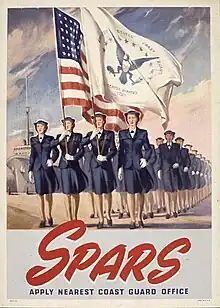
United States Coast Guard (USCG) Women's Reserve, known as the SPARS (SPARS was the acronym for "Semper Paratus—Always Ready"), was the women's branch of the United States Coast Guard Reserve. It was established by the United States Congress and signed into law by President Franklin D. Roosevelt on 23 November 1942. This law authorized the acceptance of women into the reserve as commissioned officers and at the enlisted level for the duration of World War II plus six months. Its purpose was to release officers and men for sea duty and to replace them with women at shore stations. Dorothy C. Stratton was appointed director of the SPARS with the rank of lieutenant commander and later promoted to captain.
The qualifying age for officer candidates was between 20 and 50, and they were required to have a college degree, or two years of college and two years of professional or business experience. For enlisted personnel, the qualifying age was between 20 and 36, and they were required to have completed at least two years of high school. Initially African American women were not recruited, however, late in the war five African American women were accepted and served as SPARS. Officer candidates received their indoctrination at Smith College, Northampton, Massachusetts and later at the USCG Academy, New London, Connecticut. Enlisted personnel first received their training on several college campuses. Later, their training took place at Palm Beach, Florida, in the Biltmore Hotel that was remodeled for use as a training center. Toward the end of the war, training of enlisted personnel was transferred from Palm Beach to Manhattan Beach, Brooklyn, New York.
Women of the SPARS served in every USCG district except Puerto Rico and also served in Hawaii and Alaska. Most officers were general duty officers, and most of the enlisted women performed clerical duties. The SPARS peak strength was approximately 11,000 officers and enlisted personnel. It was inactivated in 1947 but reestablished on a much smaller scale in 1949. [1] Approximately 200 former SPARS reenlisted and served during the Korean War.[2] The majority of them served at the Coast Guard Headquarters in Washington, D.C.[2] In 1973 Congressional legislation ended the Women's Reserve (SPARS) and women were first officially integrated into the active-duty Coast Guard and the Coast Guard Reserve. Female reservists then serving on active duty were given the choice of enlisting in the regular Coast Guard or completing their reserve enlistments.[3][4]
Background
The United States Coast Guard was the smallest of the U.S. military branches and had been operating under the auspices of the U.S. Department of the Treasury.[5] This changed on November 1, 1941, when Executive order 8929 directed the Coast Guard to operate as part of the Navy under the supervision of the U.S. Secretary of the Navy.[6] Following its transfer, the Coast Guard expanded with personnel needs increasing exponentially. To mitigate this it sought to allow women to serve in the USCG Reserve.[5] In late 1942 the (USCG) Women's Reserve act was passed by the U.S. Congress, and it was signed into law by President Franklin D. Roosevelt on November 23, 1942. The law amended the USCG Auxiliary and Reserve Act of 1941 in order "to expedite the war effort by providing for releasing officers and men for duty at sea as their replacement by women in the shore establishment of the Coast Guard and for other purposes." It was established as a branch of the USCG Reserve.[7] The women's reserve had the authority to enlist and appoint women to serve during World War II and for six months thereafter - or until such earlier time as the congress, by concurrent resolution, or the president, by proclamation, might designate. All reservists were to be trained and qualified for duty at the continental shore stations of the USCG. They were not to be used to replace civil service personnel. The law was similar to that of the Women's Naval Reserve, better known as the WAVES.[8] Initially, the SPARS were only to be stationed in the United States, but in 1944 they were allowed to deploy to Hawaii and Alaska (then, territories of the U.S.). [9]
The director
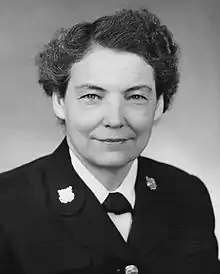
Dorothy C. Stratton (director of the SPARS) was the dean of women at Purdue University when World War II began. She earned her M.A. degree from the University of Chicago and PhD from Columbia University.[10] As the dean of women, Stratton was asked by the U.S. Army to recommend candidates for the first female officers for the Women's Army Corps (WACS). Similarly, a Purdue colleague was working with the U.S. Navy and encouraged Stratton to apply for a commission in the newly formed Women Accepted for Volunteer Emergency Service (WAVES); the women's reserve of the U.S Navy. Thinking it was a way to do something for her county, she applied and was accepted; Purdue granted her an extended leave of absence. On 26 August 1942, Stratton reported to Northampton, Massachusetts, to join the first class of female officer candidates of the WAVES. Upon graduation, she was commissioned a senior-grade lieutenant.[11]
Stratton's first duty assignment with the WAVES was at the University of Wisconsin. Within a matter of weeks after her arrival, however, she received a telegram from the Bureau of Naval Personnel to report to Washington D.C. posthaste. Once there, Stratton was ushered to the USCG's headquarters where she was informed that there was legislation pending in the U.S. Congress to form a USCG women's reserve, and that she had been recommended to become its first director. The legislation passed the congress and it was signed into law on 23 November 1942; Stratton was sworn into the USCG as Lieutenant commander the following day as the director of the SPARS. She would later be promoted to commander and to captain.[11]
The new director's first official act was to ask Mildred H. McAfee, director of the WAVES, for a core number of WAVE officers to help get the new service up and running. McAfee obliged. The next question on Stratton's mind was what should the new service be called? There was no one else to think about this, she said, so I tossed and turned for several nights contemplating this. Suddenly it came to me from the motto of the Coast Guard, Semper Paratus-Always Ready: SPAR. I proposed this to the Commandant of the USCG, Admiral Russell R. Waesche, and he accepted it. [11] There was an informal proposal to call the women's reserve WARCOGS, but it was quickly jettison for Stratton's nautical nickname of SPARS.[12] Stratton noted that the four letters (SPAR) might also stand for the four freedoms – speech, press, assembly, and religion.[13]
Stratton was responsible for establishing organizational policies; chief among them were procurement, training, and utilization of personnel. She guided the program through its launching and development. [14] Her management style was tempered by the task at hand. Stratton provided a glimpse into her style when she said, pick your fights - you can't fight them all - so chose carefully. You can't make an issue out of everything.[15] She retired from the USCG in January 1946, and by June (of the same year) the SPARS were demobilized.[14] Upon retirement, she was awarded the Legion of Merit medal for her contributions to women in the military. Stratton died at the age of 107 in 2006.[16]
Recruiting

Requirements & prohibitions
Both officer candidates and enlisted applicants had to be American citizens; have no children under 18 years of age; present three character references; pass a physical examination, and submit a record of occupation after leaving school. Officer candidates were to be college graduates, or to have completed two years of college, and have at least two years of acceptable business or professional experience and be between the ages of 20 and 50 years. Enlisted applicants were required to have completed at least two years of high school and be between the ages of 20 and 36 years. Married women could enlist provided their husbands were not in the USCG. Unmarried women had to agree not to marry until they had finished their training period. After training, they could marry a civilian or service man who was not in the USCG.[17] Another such prohibition excluded the acceptance of a woman who was already married to an officer or an enlisted man serving in the USCG.[18]
In her 1989 Oral History article, Launching the SPARS, Dorothy C. Stratton revisited the recruiting practices during her tenure as director, and said: At first we were going for perfection in our recruiting effort. As we were falling behind in our numbers, modifications to physical requirements were made. It was ridiculous to make the same physical demands of women when they weren’t going to be manning ships at sea. If we hadn’t been so inflexible in our standards at the beginning—if we’d set more reasonable ones—I’m sure we’d have been better off.[19]
General
Early on, the U.S. Navy, U.S. Marine Corps, and USCG agreed to recruit and to train the members of their respective women's reserves together by using existing Navy facilities.[20] For recruiting purposes, the SPARS would utilize the Offices of the Naval Officer Procurement. Their first recruiting efforts got underway in December 1942, but they were hampered by the absence of SPAR recruiting personnel. Their absence resulted from the agreement between the Navy and the USCG whereby the SPARS would receive its first personnel by transfer from the WAVES. A total of 15 WAVE officers and 153 WAVE enlisted women requested and were discharged from the WAVES to become the first SPARS. Eventually, SPAR officers were assigned to most of the Naval Officer Procurement offices. The recruiting information about SPARS was disseminated with WAVES publicity materials and it was also done separately. But it became apparent that the job of selling the SPARS would include selling the USCG as well.[21]
By June 1943, it was clear to the USCG that the recruiting process in place did not favor the SPARS, so it withdrew from the joint agreement effective July 1, 1943. Hence, all women applicants for SPARS would be interviewed and enlisted at USCG district recruiting stations. The change was met with enthusiasm by SPAR recruiters and it proved positive overall.[22] Still, the competition remained keen with the other, better-known women services. The SPAR recruiter's lot was not an easy one. In Three Years Behind the Mast, the author's Lyne & Arthur, former officers in the SPARS, describe the realities of recruiting in the following way:
During the day, we made speeches, distributed posters, decorated windows, led parades, manned information booths, interviewed applicants, appeared on radio programs, and gave aptitude tests. By night, we made more speeches; prayed women would be drafted, and went to bed dreaming about our quotas.[23]
The primary recruiting phase ended on December 31, 1944. During the two years of the recruiting effort, over 11,000 women had signed enlistment contracts to join the women's reserve. Many more women were interviewed.[24] One-fourth of all applicants who otherwise met the requirements were rejected for failure to pass their medical examination.[25] Dorothy Tuttle had the distinction of being the first enlistee when she enlisted in the Coast Guard Women's Reserve on December 7, 1942. As a SPAR, her rating classification was that of a Yeoman Third Class (YN3).[26]
Minority women
Native American
As early as April 1943, there was an active effort to recruit Native American women into the SPARS. In fact, no less than six women from Oklahoma’s tribal nations were the first Native Americans to serve in the SPARS during World War II; including women from the Otoe-Missouria, Choctaw, Yuchi, and Cherokee tribal nations. Nicknamed the Sooner Squadron (since Oklahoma is known as the Sooner State), these women were Seaman Mildred Cleghorn Womack (Otoe), Yeoman Corrine Koshiway Goslin (Otoe), Yeoman Lula Mae O’Bannon (Choctaw), Yeoman Lula Belle Everidge (Choctaw), June Townsend (Yuchi, Choctaw), and Yeoman Nellie Locust (Cherokee). All six were enlisted personnel.[27]
African American

Like the WAVES, the USCG did not officially open its doors to African-American women until October 1944.[28] Since November 1941, the USCG was under the supervision of the Secretary of the U.S. Navy, Frank Knox, who was vehemently opposed to the acceptance of African American women into the naval services.[29] Knox died in April 1944, and he was replaced by James Forrestal. The new secretary recommended that African American women be accepted but under some desegragated conditions. Roosevelt, the president, decided to delay any decision on the matter until after the 1944 United States presidential election on November 7. Meantime, the Republican candidate, Thomas E. Dewey, criticized the White House for discriminating against African American women during a speech in Chicago; the president then reversed himself and on October 19, 1944, he ordered the Navy to accept African-American women into the women's reserves.[29] The five African-American women who served in the SPARS before it was first inactivated in 1947 were: Olivia Hooker, D. Winifred Byrd, Julia Mosley, Yvonne Cumberbatch, and Aileen Cooke.[26] Olivia Hooker was the first of them and thus the first African-American woman to enter the U.S. Coast Guard.[30]
Training
Officer training
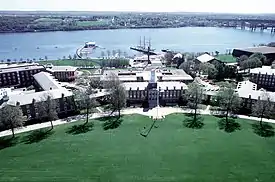
The agreement between the U.S. Navy and the USCG required that officer candidates of the SPARS would receive their indoctrination training at Smith College, Northampton, Massachusetts, which was officially the United States Naval Reserve (WR) Midshipmen's School. But in June 1943, the USCG withdrew from the agreement and the indoctrination of officer candidates was transferred to the USCG Academy at New London, Connecticut.[20][31] About 203 SPARS were enrolled in the Midshipmen's School of the women's reserve.[32] The USCG was the only U.S. military service that trained women officer candidates at its own academy.[33]
The initial training period was for six weeks but later it was increased to eight weeks.[34] The program was designed to provide candidates with an overall view of the USCG and how to become good officers. Academically, the curriculum included such subjects as administration; correspondence; communications; history; organization; personnel; public speaking; ships, and special lectures.[35] Military regimentation was also part of the training; designed to help candidates adjust to military life and to acquaint them with their responsibilities as officers.[36] In age they ranged from 24 to 40, and their civilian professions included teachers, journalists, lawyers, and technicians.[37]
During the life of the USCG officer candidates indoctrination program, a total of 955 women completed the training and were commissioned as officers. Of these, 299 came up from the enlisted ranks. Approximately, one-third of all officers received specialized training either as communication officers or as pay and supply officers. To minimize the need for such training, the USCG intentionally recruited candidates with some civilian training or work experience that could be utilized without further training of such individuals.[38] In late 1944, the USCG determined that the number of officers commissioned was sufficient and discontinued the program.[39] Later, however, the school was reopened for a final class entirely made up of former enlisted SPARS that had trained at Manhattan Beach, Brooklyn, New York. It was a way for the USCG to replace officers who were sent overseas or for those separated from the service.[40]
Enlisted training
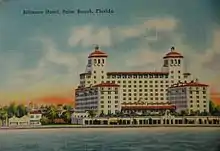
The agreement between the U.S. Navy and the USCG required that USCG enlisted recruits would receive their basic training at U.S. Naval Training Schools.[41] About 1,900 SPARS received their recruit training at Hunter College in the Bronx, New York.[42] A small number of SPARS received yeoman training at Oklahoma A&M University, Stillwater, Oklahoma, and an additional 150 of them received yeoman training at Iowa State Teachers College, Cedar Falls, Iowa[43][44] In March 1943, the USCG decided that there was a need to establish its own training center for the training of recruits and specialized training programs. The site selected was the Palm Beach Biltmore Hotel, Palm Beach, Florida; it was leased, and then commissioned as a training station on 23 May 1943. Beginning in late June, all enlisted personnel received their basic and specialized training at this station.[45]
The training period for recruits at Palm Beach was six weeks. Boot camp was designed to bridge the gap from civilian to military life. The training covered instruction on subjects such as USCG activities; organization; personnel; current events, and social hygiene. The physical education and drill aspects consisted of body mechanics; swimming; games, and drill.[46] Another important part of recruit training was the testing, classification, and selection process. This was designed to make the most of the recruit's abilities, background, and interests. The results of the testing were usually the basis for general assignments or the opportunity for specialized training.[47]
From the first class of June 14, 1943 until the final class of December 16, 1944, in excess of 7,000 recruits were trained at the Palm Beach station.[48] Approximately, 70 percent of the enlisted women who received recruit training also received some specialized training. Yeoman and storekeepers represented the largest share, many SPARS were given the opportunity for training in other fields. Some attended other Navy schools and were trained as motion picture sound technicians; link trainer operators; parachute riggers, and air control operators. Others attended USCG schools and learned to become cooks; bakers; radioman; pharmacist mates; radio technicians, and motor vehicle drivers. In January 1945, the training of enlisted personnel was transferred from Palm Beach to Manhattan Beach, Brooklyn, New York, the largest USCG training station for men.[49]
Assignments
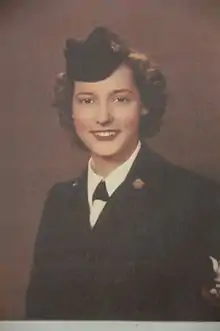
The Women of the SPARS served in every USCG district except the one located in the territory of Puerto Rico. They not only worked in the district offices, but in many of the small district field units as well. SPARS performed a wide variety of duties and, on the whole, performed them well. So much so that requests for their services by USCG commanding officers continued increasing with time. [50] However, as the women began replacing men in the workplace, the general attitude of the men toward women ranged from enthusiastic to open hostility. The authors of "Three Years Behind the Mast" explain the hostility aspect this way:
We felt that one important factor in determining a man's attitude was his own desire for sea duty. If he were eligible and wanted to shove off, he was not inclined to frown with disfavor upon his deliverer... On the other hand, it was natural that the swivel-chair commando should rail against the presence of the little lady who had come to release him for the briny deep. Fortunately the proportion of the latter was low compared with the USCG as a whole.[51]
Most of the officers served in administrative and supervisory roles in various divisions of the USCG. Others served as communication officers, supply officers, and barracks and recruiting officers.[52] The bulk of the enlisted women had clerical and stenographic civilian backgrounds and the USCG wanted them for these reasons.[50] Exciting jobs were few and far between, yet not all SPARS assigned to paperwork found it boring. Some women saw how their contribution fitted into the overall picture. Many earned petty officer ratings as yeoman and storekeepers. Enlisted personnel were found in practically every other job classification. From baking pies to rigging parachutes and driving jeeps.[53]
A select group of officers and enlisted SPARS were chosen to work with (LORAN), a Long-Range Aid to Navigation. It was a top-secret radio navigation system developed for monertering ships at sea and long ramge aircraft from stations in the continental United States. LORAN enabled stations to calculate the positions of ships at sea or long-range aircraft. The first monitoring station staffed by SPARS was at Chatham, Massachusetts, after they had received two months of instruction at M.I.T. on the operation and maintenance of LORAN. The unit at Chatham was believed to have been (at the time) the only all-female staffed one of its kind in the world.[54]
The SPARS were initially prohibited from serving in USCG districts outside the continental United States. But in late 1944, the Congress amended the law allowing SPARS to serve overseas. For the SPARS, this meant the territories of Hawaii and Alaska. However, only those with good records, good physical health, a year's service, and training and experience in the types of duty requested were selected. About 200 women served in Hawaii, doing roughly the same kind of work, and holding the same ratings that they would have held in the United States. About an equal number of women served in Alaska as well.[55]
Women of the SPARS
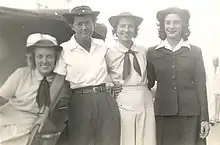
The average SPAR officer was 29 years old, single, a college graduate, and had worked seven years in a professional or managerial position (in education or government) before entering the service. The average enlisted SPAR was 24 years old, single, a high school graduate, and had worked for over three years in a clerical or sales job before joining the service. The likelihood was that she came from the state of Massachusetts, New York, Pennsylvania, Illinois, Ohio, or California.[56] The reasons for becoming a SPAR differed, but most likely it was patriotism, self-advancement, desire for travel and adventure, or the loss of a loved one in the war.[57]
In their off-duty hours, SPARS contributed time and effort to many community and wartime causes. Some became active nurse's aides, some rolled bandages for the Red Cross, others donated blood to blood banks, some visited service men in convalescent hospitals, and others collected gifts for the men overseas. Many of them were also involved in the March of Dimes campaigns, and war chest and war bond drives.[58] Both officers and enlisted were awarded ribbons and medals based on their service, and some were acknowledged for their outstanding contributions to the SPARS and the country.[59] In general, SPARS looked upon their service favorably, and many of them found a form of kinship in having been a part of the nation's military forces during wartime.[60]
Demobilization
With the surrender of Japan in August 1945, the USCG demobilization effort began, and the SPARS were gradually discharged. They were separated from the service on a point system, and on the basis of their jobs. However, many SPARS were reassigned to the personnel separation centers to help with demobilization (women and men reservists) and they were not separated until it was completed.[61] The Women's Reserve of the USCG (SPARS) was inactivated on 25 July 1947,[26] but was reestablished on a much smaller scale in 1949.[1] Approximately 200 women who had been in the SPARS reenlisted and served during the Korean War.[2] They mostly served at the Coast Guard Headquarters in Washington, D.C.[2] In 1973 women were integrated into the active-duty Coast Guard and the Coast Guard Reserve.[3] The SPARS ended and those in it were sent to the Coast Guard Reserve.[4]
Legacy
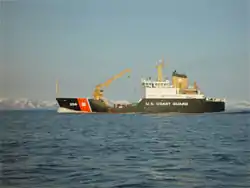
In his foreword to Three Years Behind the Mast, Commodore J. A. Hirschfield, USCG, observed that the SPARS asked no favors and no privileges. They did their jobs with enthusiasm, with efficiency, and a minimum of fanfare. The USCG was fortunate in having the help of the SPARS who volunteered for duty when their country needed them, and carried the job through to a successful finish. The USCG named two cutters in honor of the SPARS: USCGC Spar (WLB-403) was a 180-foot (55 m) sea going buoy tender commissioned in June 1944 and decommissioned in 1997,[62] and USCGC Spar (WLB-206), a 225-foot (69 m) seagoing buoy tender that was commissioned in 2001.[63]
Although the SPARS no longer exist as a separate organization, the term is sometimes informally used for a female Coast Guardsman; however, it is not an officially sanctioned term.[Note 1]
Uniforms
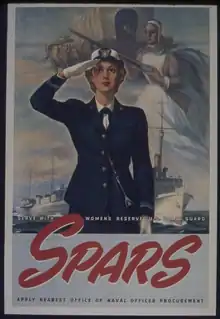
The uniforms worn by the SPARS were the same design and style as those worn by the WAVES, except for the service insignias; created for them by the New York fashion house of Mainbocher.[65] The decision made regarding the type and style of the uniforms was largely that of the U.S. Navy Uniform Board.[66] The standard uniform was a navy blue suit, consisting of a jacket and a six-gored skirt. Included were black oxfords and plain black pumps; a brimmed hat; black gloves; black leather purse, and rain and winter coats.[67] The summer uniform was of the same design as the standard uniform, worn in white Palm Beach cloth, tropical worsted, or other light fabrics. Shoes were oxfords or pumps of white leather. The summer work wear was a grey and white striped seersucker dress with jacket.[68]
See also
- WAVES (Women Accepted for Volunteer Emergency Service)
- United States Marine Corps Women's Reserve
- Women Airforce Service Pilots (WASP)
- Women in the Air Force (WAF)
- Women in the United States Navy
- Women's Army Corps (United States Army)
- Women's Auxiliary Air Force (British)
- Women's Royal Canadian Naval Service
- Women's Royal Naval Service (British) "Wrens"
- Women's Royal Australian Naval Service
References
Footnotes
- ↑ The term Coast Guardsman is the official term used by the U.S. Coast Guard to refer to a member regardless of the person's gender. In an ALCOAST message effective 1 December 2011 the Commandant, Admiral Robert Papp, directed that the language of the Guardian Ethos be superseded by the Coast Guard Ethos in an effort to use terminology that would help with the identity of personnel serving in the Coast Guard. The term Coast Guardsman is the correct form of address used in Title 14 USC and is the form that has been used historically.[64]
Citations
- 1 2 "Women in Coast Guard: Historical Chronology". www.history.uscg.mil.
- 1 2 3 4 Paul M. Edwards (1 January 2006). The Korean War. Greenwood Publishing Group. pp. 53–. ISBN 978-0-313-33248-7.
- 1 2 "Women in Coast Guard: Historical Chronology". www.history.uscg.mil.
- 1 2 "Women in Coast Guard: Historical Chronology".
- 1 2 Yellin, p 142
- ↑ "Executive Order - November 1, 1941". The American Presidency Project. Retrieved August 17, 2023.
- ↑ USCG AT WAR-Women's Reserve 1946, p. 3.
- ↑ USCG AT WAR-Women's Reserve 1946, pp. 3–5.
- ↑ Yellin 2004, p. 145.
- ↑ Dorothy C, Stratton 2006.
- 1 2 3 Launching the SPARS 1989.
- ↑ Captain Dorothy Stratton 2003.
- ↑ USCG AT WAR-Women's Reserve 1946, p. 5.
- 1 2 Women's History Month 2013.
- ↑ Lunching the SPARS 1989.
- ↑ Dorothy C. Stratton 2006.
- ↑ USCG at War - Women's Reserve 1946, p. 15.
- ↑ USCG at War - Women's Reserve 1946, p. 23.
- ↑ Launchingr the SPARS 1989.
- 1 2 Johnson, pp 198–199
- ↑ USCG AT WAR-Women's Reserve 1946, p. 13-15.
- ↑ USCG AT WAR-Women's Reserve 1946, p. 21.
- ↑ Lyne & Arthur 1946, p. 18.
- ↑ USCG at War - Women's Reserve 1946, p. 51.
- ↑ USCG at War - Women's Reserve 1946, p. 57.
- 1 2 3 Women & the U.S. Coast Guard
- ↑ The Long Blue Line: “Sooner Squadron” SPARS Stories History Program - 2021 |https://www.mycg.uscg.mil/News/Article/2826944/the-long-blue-line-sooner-squadronfirst-native-american-women-to-enlist-in-the/
- ↑ Yellen 2004, p. 216.
- 1 2 MacGregor 2001, p. 87.
- ↑ "Olivia Hooker: 1921 Tulsa race riot survivor dies aged 103 - BBC News". Bbc.com. 25 November 2018. Retrieved 2019-06-24.
- ↑ A Preliminary Survey of the Development of the Women's Reserve of the United States Coast Guard, p 95
- ↑ Goodson 2001, p. 118.
- ↑ Lyne & Arthur 1946, p. 39.
- ↑ USCG At War - Women's Reserve 1946, p. 103.
- ↑ USCG At War - Women's Reserve 1946, p. 105.
- ↑ USCG At War - Women's Reeerve 1946, p. 107.
- ↑ Lyne & Arthur 1946, p. 41.
- ↑ Lyne & Arthur 1946, p. 107.
- ↑ USCG At War - Women's Reserve 1946, p. 117.
- ↑ Lyne & Arthur 1946, p. 108.
- ↑ USCG At War - Women's Reserve 1946, p. 63.
- ↑ Lyne & Arthur 1946, p. 25.
- ↑ Lyne & Arthur 1946, p. 23-24.
- ↑ USCG At War - vWomen's Reserve 1946, p. 65.
- ↑ USCG At War -vWomen's Reserve 1946, p. 69.
- ↑ USCG At War - Women's Reserve 1946, p. 77.
- ↑ USCG At War - Women's Reserve 1946, p. 78.
- ↑ Lyne & Arthur 1946, p. 27.
- ↑ Lyne & Arthur 1946, p. 105.
- 1 2 Lyne & Arthur 1946, p. 67.
- ↑ Lyne & Arthur 1946, p. 70.
- ↑ Lyne & Arthur 1946, p. 111.
- ↑ Lyne & Arthur 1946, p. 68.
- ↑ Lyne & Arthur 1946, pp. 115–117.
- ↑ Lyne & Arthur 1946, pp. 90–93.
- ↑ Lyne & Arthur, p 103
- ↑ Lyne & Arthur, p 17
- ↑ Lyne & Arthur, pp 117–118
- ↑ Lyne & Arthur, pp 111–114
- ↑ Lyne & Arthur, p 101
- ↑ Lyne & Arthur, p 99
- ↑ Spar, 1944
- ↑ CGC Spar (WLB-206) History
- ↑ Shipmates 17 – The Coast Guard Ethos
- ↑ Lyne & Arthur, p 103
- ↑ A Preliminary Survey of the Development of the Women's Reserve of the United States Coast Guard, p 133
- ↑ Goodson, p 124
- ↑ Lyne & Arthur, p 104
Bibliography
- "A Preliminary Survey of the Development of the Women's Reserve of the United States Coast Guard" (PDF). U.S. Coast Guard Historical Section - Washington, D.C. April 1946. Retrieved 8 January 2013.
- "Captain Dorothy Stratton". USCG 2003. Retrieved 21 November 2023.
- Ebbert, Jean & Hall, Marie-Beth (1993). Crossed Currents. Washington, D.C.: Brassey's. ISBN 978-1-57488-193-6.
{{cite book}}: CS1 maint: multiple names: authors list (link) - Goodson, Susan, H (2001). Serving Proudly. Annapolis, MD: Naval Institute Press. ISBN 1-55750-317-6.
{{cite book}}: CS1 maint: multiple names: authors list (link) - Johnson, Robert Irwin (1987). Guardians of the Sea, History of the United States Coast Guard, 1915 to the Present. Naval Institute Press, Annapolis, Maryland. ISBN 978-0-87021-720-3.
- "Moments in History". Women & the U. S. Coast Guard. U.S. Coast Guard Historian's Office. Retrieved 2 February 2016.
- "Shipmates 17 – The Coast Guard Ethos" (txt). CGMS General Messages. 30 November 2011. ALCOAST 554/11.
- "Spar, 1944". Cutters, Craft & U.S. Coast Guard Manned Army & Navy Vessels. U.S. Coast Guard Historian's Office. Retrieved 2 February 2016.
- "CGC Spar (WLB-206) History". U.S. Coast Guard District 17. Retrieved 2 February 2016.
- Soderbergh, Peter, A. (1992). Women Marines: The World War II Era. Westport, CT: Praeger Publishers. ISBN 0-275-94131-0.
{{cite book}}: CS1 maint: multiple names: authors list (link) - Lyne, Mary; Arthur, Kay (1946). Three Years Behind The Mast. Washington, DC: U.S. Coast Guard.
- "Women in Coast Guard: Historical Chronology". www.history.uscg.mil.
- "Dorothy C. Stratton, Purdue's first dean of women, dies at 107 in 2006". Purdue University. Retrieved October 28, 2023.
- "USCG AT WAR - Women's Reserve (Volume XXII)" (PDF). U.S. Coast Guard Historical Section, Public Information Division, U.S. Coast Guard Headquarters - Washington, D.C. April 15, 1946. Retrieved October 20, 2023.
- "SPARS: The Coast Guard & the Women's Reserve in World War II". United States Coast Guard. Retrieved October 26, 2023.
- "Launching the SPARS". U.S. Naval History Magazine 1989. Retrieved 21 November 2023.
- "Women's History Month - Captain Dorothy Stratton". DVIDS - Courtesy story by the USCG District 14 Hawaii Pacific 2013. Retrieved November 23, 2023.
- MacGregor, Morris J. Jr. (2001). Integration of the Armed Forces 1940–1965 (PDF). Defense Studies Series. Washington, DC: Center of Military History, United States Army. OCLC 713016456. Retrieved March 30, 2018.
- Yellin, Emily (2004). Our Mother's War (2004 ed.). New York: Free Press. ISBN 0-7432-4514-8.
Further reading
- Campbell, D'Ann (1987). "Women in Uniform: The World War II Experiment". Military Affairs. 51 (3): 137–139. doi:10.2307/1987516. JSTOR 1987516.
- Litoff, Judy Barrett, and Smith, David C.; "The Wartime History of the Waves, SPARS, Women Marines, Army and Navy Nurses, and WASP's." in A Women's War Too: US Women in the Military in World War II ed. by Paula Nassen Poulos.(Washington: National Archives and Records Administration, 1996) pp 47–67
External links
- "Facts about SPARS". U.S. Navy Department-Coast Guard. Retrieved 19 February 2016.
- SPARS history and WWII women's uniforms in color—World War II US women's service organizations (WAC, WAVES, ANC, NNC, USMCWR, PHS, SPARS, ARC, and WASP)
